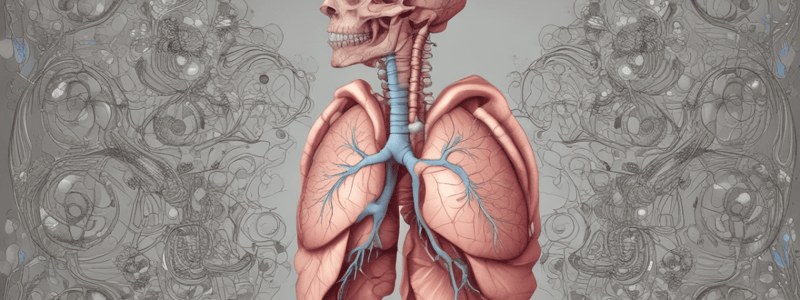Podcast
Questions and Answers
What does the term 'pulmonary' relate to?
What does the term 'pulmonary' relate to?
- The liver
- The heart
- The kidneys
- The lungs (correct)
What is the plural form of the term for the airway that leads to the lungs?
What is the plural form of the term for the airway that leads to the lungs?
- Trachea
- Alveoli
- Bronchi (correct)
- Bronchus
What is the term for the inner space within a tubular organ?
What is the term for the inner space within a tubular organ?
- Cilia
- Alveolus
- Hilum
- Lumen (correct)
What is the term for the indentation in an organ where blood vessels, ducts, etc. enter or leave the organ?
What is the term for the indentation in an organ where blood vessels, ducts, etc. enter or leave the organ?
What are small hair-like projections from a cell membrane?
What are small hair-like projections from a cell membrane?
What is the function of the hilum in an organ?
What is the function of the hilum in an organ?
What is the term for the small air sacs where gas exchange occurs in the lungs?
What is the term for the small air sacs where gas exchange occurs in the lungs?
What is the function of cilia in the lungs?
What is the function of cilia in the lungs?
What is the term for the inner space within a tubular organ?
What is the term for the inner space within a tubular organ?
What is the term that relates to the lungs?
What is the term that relates to the lungs?
The plural form of bronchus is bronchi.
The plural form of bronchus is bronchi.
Alveoli are the inner spaces within a tubular organ.
Alveoli are the inner spaces within a tubular organ.
The hilum is the site where gas exchange occurs in the lungs.
The hilum is the site where gas exchange occurs in the lungs.
Cilia are found on the surface of cells in the lungs and aid in gas exchange.
Cilia are found on the surface of cells in the lungs and aid in gas exchange.
The term 'pulmonary' refers to the kidneys.
The term 'pulmonary' refers to the kidneys.
The term 'pulmonary' is related to the ______.
The term 'pulmonary' is related to the ______.
The plural form of bronchus is ______.
The plural form of bronchus is ______.
The inner space within a tubular organ is referred to as the ______.
The inner space within a tubular organ is referred to as the ______.
The indentation in an organ where blood vessels, ducts, etc. enter or leave the organ is called the ______.
The indentation in an organ where blood vessels, ducts, etc. enter or leave the organ is called the ______.
Small hair-like projections from a cell membrane are called ______.
Small hair-like projections from a cell membrane are called ______.
What is the primary function of the respiratory system?
What is the primary function of the respiratory system?
What is the role of the olfactory nerve in the nasal cavity?
What is the role of the olfactory nerve in the nasal cavity?
What is the term for the process of regulating body temperature?
What is the term for the process of regulating body temperature?
Where are the vocal cords located?
Where are the vocal cords located?
What is the function of panting in thermoregulation?
What is the function of panting in thermoregulation?
The respiratory system is responsible for removing oxygen from the tissues.
The respiratory system is responsible for removing oxygen from the tissues.
The vocal cords are located in the nasal cavity.
The vocal cords are located in the nasal cavity.
Panting is a mechanism used to retain heat in thermoregulation.
Panting is a mechanism used to retain heat in thermoregulation.
The olfactory nerve is responsible for the sense of smell.
The olfactory nerve is responsible for the sense of smell.
The respiratory system is only responsible for providing oxygen to the tissues.
The respiratory system is only responsible for providing oxygen to the tissues.
Match the following respiratory functions with their descriptions:
Match the following respiratory functions with their descriptions:
Match the following components with their locations:
Match the following components with their locations:
Match the following processes with their purposes:
Match the following processes with their purposes:
Match the following senses with their associated organs:
Match the following senses with their associated organs:
Match the following thermoregulation mechanisms with their effects:
Match the following thermoregulation mechanisms with their effects:
What is the primary function of the respiratory system?
What is the primary function of the respiratory system?
Where are the vocal cords located?
Where are the vocal cords located?
What is the role of panting in thermoregulation?
What is the role of panting in thermoregulation?
What is the role of the olfactory nerve in the nasal cavity?
What is the role of the olfactory nerve in the nasal cavity?
What is another function of the respiratory system?
What is another function of the respiratory system?
What is the main difference between the upper and lower respiratory tracts?
What is the main difference between the upper and lower respiratory tracts?
Which of the following is NOT a part of the upper respiratory tract?
Which of the following is NOT a part of the upper respiratory tract?
What is the function of the pharynx in the upper respiratory tract?
What is the function of the pharynx in the upper respiratory tract?
Which of the following is a part of the lower respiratory tract?
Which of the following is a part of the lower respiratory tract?
Why is the trachea considered part of the lower respiratory tract in this course?
Why is the trachea considered part of the lower respiratory tract in this course?
What is the main difference between the upper and lower respiratory tracts?
What is the main difference between the upper and lower respiratory tracts?
Which of the following is a part of the lower respiratory tract?
Which of the following is a part of the lower respiratory tract?
What is the function of the pharynx in the upper respiratory tract?
What is the function of the pharynx in the upper respiratory tract?
Why is the trachea considered part of the lower respiratory tract in this course?
Why is the trachea considered part of the lower respiratory tract in this course?
Which of the following is NOT a part of the upper respiratory tract?
Which of the following is NOT a part of the upper respiratory tract?
Flashcards are hidden until you start studying
Study Notes
Respiratory System Terminology
- Pulmonary refers to the lungs or relating to the lungs
- Bronchi (plural) are the airways that branch off from the trachea and lead to the lungs, while bronchus (singular) is a single airway
- Alveoli (plural) are the tiny sacs within the lungs where gas exchange occurs, and alveolus (singular) is a single sac
- Lumen is the inner space within a tubular organ, such as a blood vessel or airway, and can also refer to an opening
- Hilus or hilum is the indentation in an organ, such as the lung, kidney, or spleen, where blood vessels, ducts, and other structures enter or leave the organ
- Cilia are small hair-like projections from the cell membrane that help move particles or substances along the surface of the cell
Studying That Suits You
Use AI to generate personalized quizzes and flashcards to suit your learning preferences.





